Well, it was looking a little tired, and it wasn't the easiest to navigate. With plans to post more behind the scenes stories, news, opinions, coverage from our festivals and events, and some special guest posts, we thought it was about time the blog had a fresh new look.
I'm in the process of moving the posts from Blogger to Wordpress, and there are one or two tweaks to be made, but until everything is up and running, you can still read all of our posts on Blogger.
Find our new blog on Wordpress, and tell your friends:
http://nationalmediamuseumblog.wordpress.com
22 April, 2012
19 March, 2012
My writing life on the web
Guest blogger: Adrian Slatcher, Life Online Advisory Panel Member
In 1998 I had just completed an M.A. in creative writing at the University of Manchester. I had a decent computer running Windows 3.11 and had invested one hundred and fifty quid in a modem which necessitated running a second phone line into the bedroom of my shared house, taking care only to go online when the rest of the house didn't need the phone. If you wanted to get in touch with me (I gave out my email address on the photocopied short story magazine I gave out to friends), then 101456.1226@compuserve.com was all you needed to remember.
It would be a couple of years before I watched live TV on the internet (on September 11th 2001 to be accurate), and downloading a photograph or an MP3 file was painfully slow. However, text was different. I'd not yet made my own web-page, but I knew you could, and besides, there were plenty of great online resources for writers.
I can't remember how I found out about the online writers' group run by Francis Ford Coppola's Zoetrope studios, but when I did I became addicted to it. Years before Web 2.0 and social media, here was a user-generated lit-crit site, free to join, and with an active, vociferous user base of real writers, albeit mostly in the USA and Canada. Coppola's films have regularly come from books (S.E. Hinton, Mario Puzo and Joseph Conrad amongst them) and his support for the short form, via this and the All-Story magazine were not without self-interest.
For the writers it was great. You critiqued a few stories with a few lines, and that gave you enough credit to upload your own story. I must have read two hundred stories during my few months on the site. Every month there was a competition, with the top rated stories going through to be read by an agent or something. Yet, years before Klout and record-breaking headcounts of Facebook friends or Twitter followers, the group dynamics of the web were already in play.
Some writers were vociferous joiners, frienders, whatever. They had their own clique who extravagantly praised everything they wrote, and they presumably returned the compliment. Around these Ashton Kutcher-like stars of the late 20th century online world, little satellites of like minded writers buzzed in there own mini-ecosystems. If only Google+ circles had been available to us then! I had my own little coterie, writers I liked and who liked my work – and I'd get home from work to see if anyone had responded to the story I'd put online late the night before.
Occasionally, in the forum someone would set a challenge, such as "let's all write a story with a character named Marvin in the title." At some point – perhaps around having read 200 stories – I lost a bit of interest in my online writers groups. There were new cliques on the island, and going through all that "making friends" thing again seemed a little tiresome. One of those friends, the English novelist Laura Denham, was based in San Francisco, and in a nice twist, when she moved back to London to live, she was the first person I'd met online that I later met in real life. We're still in touch.
The possibility of the web, as a writer, was there from almost the first time I logged in. A year or so before Blogger, I was posting my own online writers diary (using Frontpage Express), and had some of my stories online. The web also inspired my work. I wrote an ongoing satire about this new culture, called "Where do you want to go today?" purloining Microsoft's current advertising campaign, which today reads like a list of dot com memes.
I've blogged about literature online for best part of a decade; have seen how online magazines are now as respected as print ones (and with a much wider readership); and have replaced photocopying my magazine with perfect bound books from Lulu.com.
Strangely though, despite the internet's present ubiquity, and the move to mobile, it was that first wonderfully communal experience of the Zoetrope online writers' group that I still remember so fondly. The possibilities were there from the start, and we're only just beginning to come to grips with them.
Adrian Slatcher blogs about literature at artoffiction.blogspot.com his website is www.adrianslatcher.com. He works for Manchester Digital Development Agency managing European projects, and frequently advises the arts about how best to use technology.
In 1998 I had just completed an M.A. in creative writing at the University of Manchester. I had a decent computer running Windows 3.11 and had invested one hundred and fifty quid in a modem which necessitated running a second phone line into the bedroom of my shared house, taking care only to go online when the rest of the house didn't need the phone. If you wanted to get in touch with me (I gave out my email address on the photocopied short story magazine I gave out to friends), then 101456.1226@compuserve.com was all you needed to remember.
It would be a couple of years before I watched live TV on the internet (on September 11th 2001 to be accurate), and downloading a photograph or an MP3 file was painfully slow. However, text was different. I'd not yet made my own web-page, but I knew you could, and besides, there were plenty of great online resources for writers.
I can't remember how I found out about the online writers' group run by Francis Ford Coppola's Zoetrope studios, but when I did I became addicted to it. Years before Web 2.0 and social media, here was a user-generated lit-crit site, free to join, and with an active, vociferous user base of real writers, albeit mostly in the USA and Canada. Coppola's films have regularly come from books (S.E. Hinton, Mario Puzo and Joseph Conrad amongst them) and his support for the short form, via this and the All-Story magazine were not without self-interest.
For the writers it was great. You critiqued a few stories with a few lines, and that gave you enough credit to upload your own story. I must have read two hundred stories during my few months on the site. Every month there was a competition, with the top rated stories going through to be read by an agent or something. Yet, years before Klout and record-breaking headcounts of Facebook friends or Twitter followers, the group dynamics of the web were already in play.
Some writers were vociferous joiners, frienders, whatever. They had their own clique who extravagantly praised everything they wrote, and they presumably returned the compliment. Around these Ashton Kutcher-like stars of the late 20th century online world, little satellites of like minded writers buzzed in there own mini-ecosystems. If only Google+ circles had been available to us then! I had my own little coterie, writers I liked and who liked my work – and I'd get home from work to see if anyone had responded to the story I'd put online late the night before.
Occasionally, in the forum someone would set a challenge, such as "let's all write a story with a character named Marvin in the title." At some point – perhaps around having read 200 stories – I lost a bit of interest in my online writers groups. There were new cliques on the island, and going through all that "making friends" thing again seemed a little tiresome. One of those friends, the English novelist Laura Denham, was based in San Francisco, and in a nice twist, when she moved back to London to live, she was the first person I'd met online that I later met in real life. We're still in touch.
The possibility of the web, as a writer, was there from almost the first time I logged in. A year or so before Blogger, I was posting my own online writers diary (using Frontpage Express), and had some of my stories online. The web also inspired my work. I wrote an ongoing satire about this new culture, called "Where do you want to go today?" purloining Microsoft's current advertising campaign, which today reads like a list of dot com memes.
I've blogged about literature online for best part of a decade; have seen how online magazines are now as respected as print ones (and with a much wider readership); and have replaced photocopying my magazine with perfect bound books from Lulu.com.
Strangely though, despite the internet's present ubiquity, and the move to mobile, it was that first wonderfully communal experience of the Zoetrope online writers' group that I still remember so fondly. The possibilities were there from the start, and we're only just beginning to come to grips with them.
Adrian Slatcher blogs about literature at artoffiction.blogspot.com his website is www.adrianslatcher.com. He works for Manchester Digital Development Agency managing European projects, and frequently advises the arts about how best to use technology.
Labels:
adrian slatcher,
blogging,
creative writing,
internet,
life online,
publishing,
web,
zoetrope studios
Location:
Bradford, West Yorkshire, UK
07 March, 2012
In the Blink of an Eye: Installing a Timeslice
Blogger: Beth Hughes, Exhibitions Assistant
Installing a new exhibition involves facing many challenges - it's not all just hanging pictures on a wall - and today we tackled quite a challenge. As part of our forthcoming exhibition, In the Blink of an Eye: Media and Movement, we will be displaying a Timeslice.
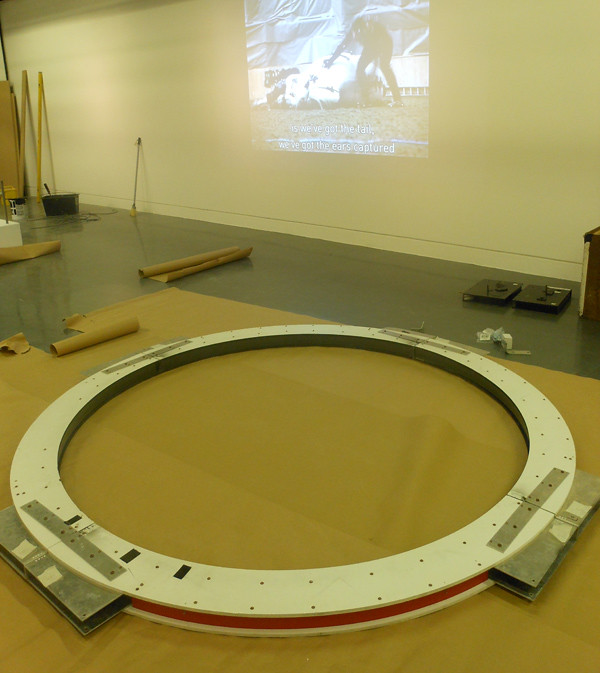
A Timeslice is a large ring with a series of cameras facing into the centre of the circle. When an object passes through the circle, all the cameras simultaneously take a picture. When shown in sequence it seems as if the camera can pan around and see every angle of whatever has passed through the Timeslice. The object is frozen in time and space. This technology is widely used in both television and film, most notably in the Matrix films.
The Timeslice can take hundreds of images capturing one moment in time. Unlike a normal camera, there aren't any lenses or shutters, just a single strip of film around the inside. When an object passes through the circle a flash goes off exposing the film through a series of tiny pinholes. This means that the images have to be taken in the dark to ensure no early exposure.
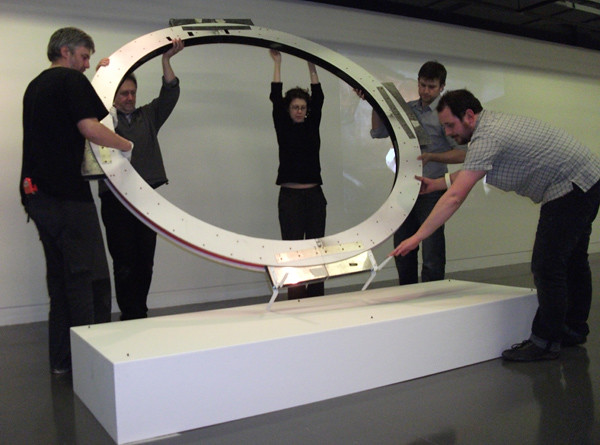
Although not too heavy, the Timeslice is a tricky item to handle. Standing at eight feet in diameter, it took five of our best employees to safely install and secure it.
The Timeslice on display was donated to the Museum by Tim Macmillan who pioneered the technology in the 1990s. This will be the first time we have displayed it in the Museum, but it had a starring role on an episode of Tomorrow's World in May 1993.
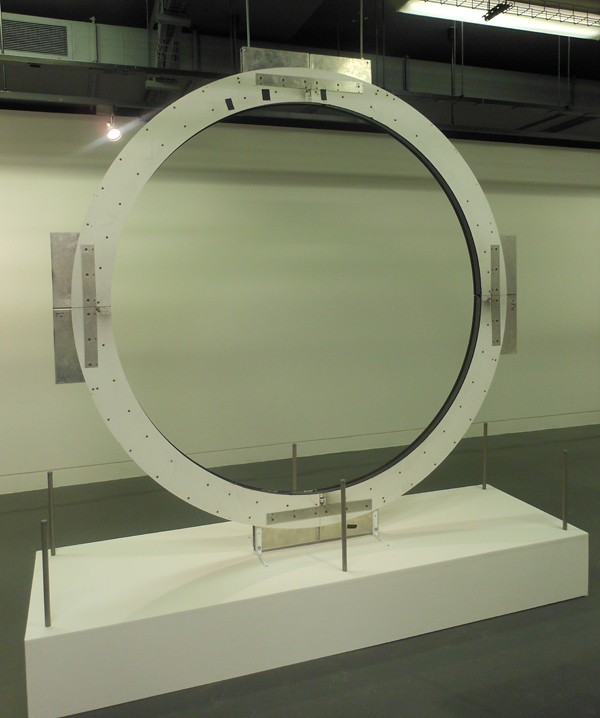
In the Blink of an Eye reveals our fascination with movement and our desire to capture it through photography, film, television and new media. The exhibition is on display in Galleries 1 and 2 from 9 March – 2 September 2012.
Installing a new exhibition involves facing many challenges - it's not all just hanging pictures on a wall - and today we tackled quite a challenge. As part of our forthcoming exhibition, In the Blink of an Eye: Media and Movement, we will be displaying a Timeslice.

A Timeslice is a large ring with a series of cameras facing into the centre of the circle. When an object passes through the circle, all the cameras simultaneously take a picture. When shown in sequence it seems as if the camera can pan around and see every angle of whatever has passed through the Timeslice. The object is frozen in time and space. This technology is widely used in both television and film, most notably in the Matrix films.
The Timeslice can take hundreds of images capturing one moment in time. Unlike a normal camera, there aren't any lenses or shutters, just a single strip of film around the inside. When an object passes through the circle a flash goes off exposing the film through a series of tiny pinholes. This means that the images have to be taken in the dark to ensure no early exposure.

Although not too heavy, the Timeslice is a tricky item to handle. Standing at eight feet in diameter, it took five of our best employees to safely install and secure it.
The Timeslice on display was donated to the Museum by Tim Macmillan who pioneered the technology in the 1990s. This will be the first time we have displayed it in the Museum, but it had a starring role on an episode of Tomorrow's World in May 1993.

In the Blink of an Eye reveals our fascination with movement and our desire to capture it through photography, film, television and new media. The exhibition is on display in Galleries 1 and 2 from 9 March – 2 September 2012.
Labels:
beth hughes,
cultural olympiad,
exhibition,
imove,
in the blink of an eye,
movement,
photography,
timeslice
Location:
Bradford, West Yorkshire, UK
05 March, 2012
How we test the Life Online gallery exhibits
Blogger: Catherine Elvin, Audience Researcher and Advocate
My role in the Life Online team is to find out how our visitors react to each element of the galleries, and to look for ways that we can improve their experiences. I go out and talk to our audiences, with the aim of discovering what they find interesting and engaging, and what might be confusing or difficult to understand.
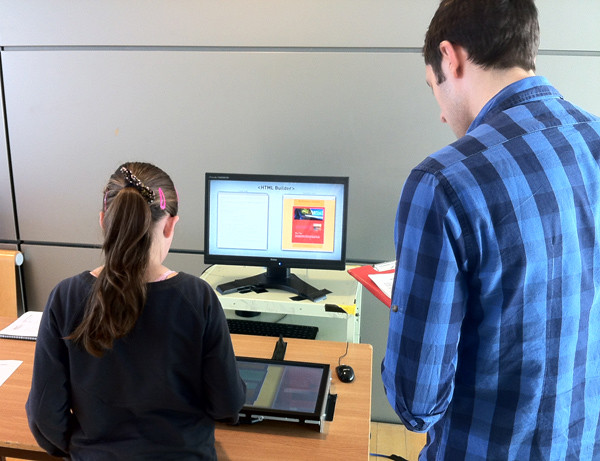
One of the best things about my role is that I get to work with everybody on the team, and see how things are progressing with all areas of the project, from the exhibitions and galleries to the websites and workshops.
One of the largest areas of work for Life Online has been testing the new interactive exhibits with visitors. I've been involved all the way along in developing these exhibits, and my team are currently doing some testing with working prototypes.
For the Life Online gallery, all the interactive exhibits are touch-screen, computer-based exhibits. They look at very different elements of the history and use of the internet; how the internet has replaced older technologies; what the early web looked like; how online businesses have succeeded and failed. The prototypes aren't always finished exhibits - usually we'll be wheeling a computer around on a trolley - sometimes it will just be an idea explained using a slide show or on paper.
We ask visitors to have a go at the exhibit, and imagine they've just encountered it in a gallery, then we ask some questions to ascertain what they particularly liked about it and which bits still need work. When we've collected a range of different opinions about the exhibit, we talk to the design team about what they can do to improve the exhibit based on that feedback. This can be anything from making the key messages clearer, to changing where buttons are on the screen to make a game more intuitive to play.
We've nearly finished working on the interactive exhibits, and it's exciting to see everything coming together as we get closer to the final install date.
My role in the Life Online team is to find out how our visitors react to each element of the galleries, and to look for ways that we can improve their experiences. I go out and talk to our audiences, with the aim of discovering what they find interesting and engaging, and what might be confusing or difficult to understand.

One of the best things about my role is that I get to work with everybody on the team, and see how things are progressing with all areas of the project, from the exhibitions and galleries to the websites and workshops.
One of the largest areas of work for Life Online has been testing the new interactive exhibits with visitors. I've been involved all the way along in developing these exhibits, and my team are currently doing some testing with working prototypes.
For the Life Online gallery, all the interactive exhibits are touch-screen, computer-based exhibits. They look at very different elements of the history and use of the internet; how the internet has replaced older technologies; what the early web looked like; how online businesses have succeeded and failed. The prototypes aren't always finished exhibits - usually we'll be wheeling a computer around on a trolley - sometimes it will just be an idea explained using a slide show or on paper.
We ask visitors to have a go at the exhibit, and imagine they've just encountered it in a gallery, then we ask some questions to ascertain what they particularly liked about it and which bits still need work. When we've collected a range of different opinions about the exhibit, we talk to the design team about what they can do to improve the exhibit based on that feedback. This can be anything from making the key messages clearer, to changing where buttons are on the screen to make a game more intuitive to play.
We've nearly finished working on the interactive exhibits, and it's exciting to see everything coming together as we get closer to the final install date.
Labels:
audience testing,
catherine elvin,
galleries,
interactives,
life online
Location:
Bradford, West Yorkshire, UK
29 February, 2012
Creating films for Life Online
Blogger: Emma Shaw, Media Developer
Getting the opportunity to work on a brand new gallery doesn't happen very often, so when work began on Life Online and we found out we were going to make video content for it, we were very excited.
Creating videos for a gallery is fun, because you get to learn about the subject, film interesting people, and come up with creative ways to explain people's ideas in films that can be as short as one minute! We've learned a great deal about the history and development of the internet from the Life Online team, and we've had the chance to work with the founders of the internet, the people whose ideas created the online world we know today.
One man we had the pleasure to film was Vint Cerf, who not only co-created the foundations for the internet back in 1973, but inspired the character of 'the architect' in The Matrix Reloaded movie... what greater accolade?
We met him in a small meeting room in Oxford while he was in the UK attending a debate about the future of the internet. He gave us his time for free, waited patiently as we set up the camera, answered all our questions (intelligent technical ones from Life Online curator Tom, and less intelligent ones from me, "can you tell us, again, about the time when you turned OFF the internet?") and even though we overran our allocated time, he stayed with us to make sure we had everything we needed. He is one of the nicest men I've ever met. You can see him in films all around the galleries, explaining how it all began.
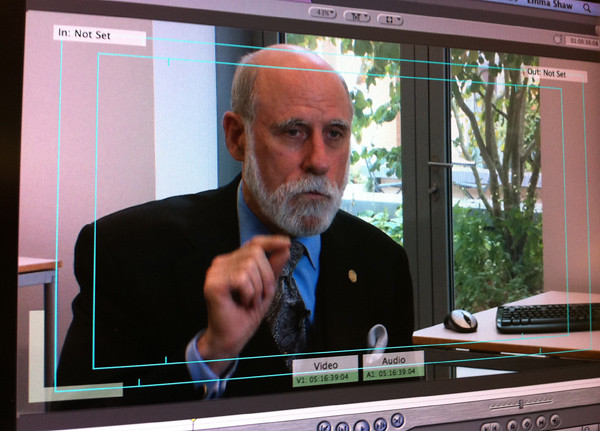
We also recorded some interviews over Skype, with legendary figures such as Ray Tomlinson, who is credited with being the inventor of email. He told us about sitting in his office late one evening, acting upon an idea he'd had to send electronic mail between computers. In that moment he effectively changed the way we all communicate today - can you imagine life before email? When he achieved this, it was so late in the evening that the building was empty, so he didn't even have anyone to tell!
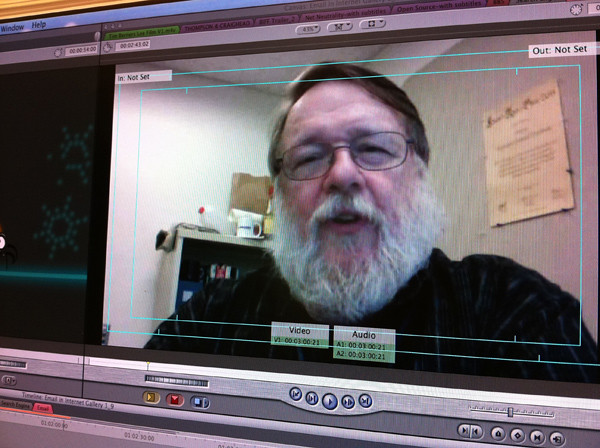
There were some creative challenges, like how to explain what TCP/IP is, in a way that we could understand ourselves. Our in-house animator Sven Shaw came to the rescue and created some beautiful animations which show how TCP/IP enables pockets of information to be carried along the networks, like pigeons carrying mail, effectively allowing information to flow freely and efficiently across the networks. You can see the full film in the gallery.
Want to know how a search engine works? Find our in the gallery, with the help of our friendly web crawler spider.

It's not all been hard work. We've enjoyed watching old technology programmes from the 1980s which announced great innovations such as the floppy disk, and computers which could connect to a network via the telephone (if you have a few hours to wait), so people could talk to each other online for the very first time.
It's amazing to be a part of the Life Online team, and we hope you enjoy watching our videos as much as we enjoyed making them.
Your own videos can be a part of Life Online too. Visit www.nmemlol.wordpress.com and take part in missions for the Your Life Online Project.
Getting the opportunity to work on a brand new gallery doesn't happen very often, so when work began on Life Online and we found out we were going to make video content for it, we were very excited.
Creating videos for a gallery is fun, because you get to learn about the subject, film interesting people, and come up with creative ways to explain people's ideas in films that can be as short as one minute! We've learned a great deal about the history and development of the internet from the Life Online team, and we've had the chance to work with the founders of the internet, the people whose ideas created the online world we know today.
One man we had the pleasure to film was Vint Cerf, who not only co-created the foundations for the internet back in 1973, but inspired the character of 'the architect' in The Matrix Reloaded movie... what greater accolade?
We met him in a small meeting room in Oxford while he was in the UK attending a debate about the future of the internet. He gave us his time for free, waited patiently as we set up the camera, answered all our questions (intelligent technical ones from Life Online curator Tom, and less intelligent ones from me, "can you tell us, again, about the time when you turned OFF the internet?") and even though we overran our allocated time, he stayed with us to make sure we had everything we needed. He is one of the nicest men I've ever met. You can see him in films all around the galleries, explaining how it all began.

We also recorded some interviews over Skype, with legendary figures such as Ray Tomlinson, who is credited with being the inventor of email. He told us about sitting in his office late one evening, acting upon an idea he'd had to send electronic mail between computers. In that moment he effectively changed the way we all communicate today - can you imagine life before email? When he achieved this, it was so late in the evening that the building was empty, so he didn't even have anyone to tell!

There were some creative challenges, like how to explain what TCP/IP is, in a way that we could understand ourselves. Our in-house animator Sven Shaw came to the rescue and created some beautiful animations which show how TCP/IP enables pockets of information to be carried along the networks, like pigeons carrying mail, effectively allowing information to flow freely and efficiently across the networks. You can see the full film in the gallery.
Want to know how a search engine works? Find our in the gallery, with the help of our friendly web crawler spider.

It's not all been hard work. We've enjoyed watching old technology programmes from the 1980s which announced great innovations such as the floppy disk, and computers which could connect to a network via the telephone (if you have a few hours to wait), so people could talk to each other online for the very first time.
It's amazing to be a part of the Life Online team, and we hope you enjoy watching our videos as much as we enjoyed making them.
Your own videos can be a part of Life Online too. Visit www.nmemlol.wordpress.com and take part in missions for the Your Life Online Project.
Labels:
emma shaw,
filming,
galleries,
internet,
life online,
new media,
ray tomlison,
vint cerf,
web,
your life online
Location:
Bradford, West Yorkshire, UK
22 February, 2012
"System Overload" youth project ready for Life Online [open source]
Blogger: Dave Smith, Life Online Youth Engagement Officer
Six months ago, a group of dedicated young people came together to work on the development of a brand new artwork as part of the Life Online project. Here we are in February and the fruits of their labours have just been installed in the Level 7 gallery, as a piece called System Overload. So, how did we get here?
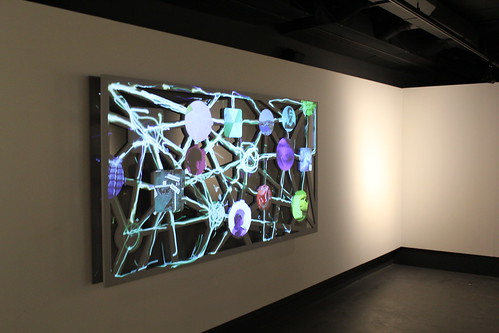
It all began back in September. A month earlier the group had voted to make an animation about net neutrality and with the help of artist Jack Lockhart they embarked on a series of workshops and activities. The aim: to learn how to animate and how to make cool art.
The first thing the group did was create a visual language to use, playing with concepts, ideas and techniques, working out how to represent abstract things like "the internet" as interesting animations. The results were three animation techniques: stop-motion, lightwriting and pixilation, and some ideas about where to go next. The group also researched the net neutrality and started to have ideas about why it's an important topic and what they wanted to say about it.
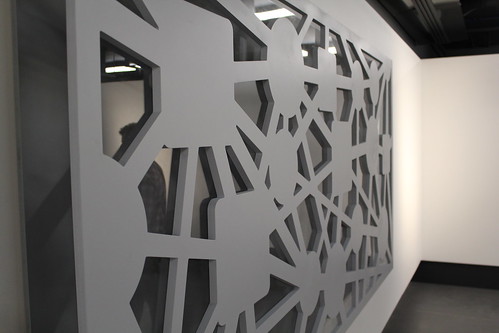
The next item on the agenda was to develop a structure for the artwork. As the piece was going in a gallery we didn't want a projection onto a wall, not when there was the chance to make something more interesting. As the group talked, the idea of using nodes and lines developed, and we combined this with experiments in projecting onto 3D objects like boxes. The result was a pattern, to be cut from wood and hung in the gallery: the animations would be projected on this later on.
With the structure in place we got on with animating. Led by our "meme master" Callum, the group started to create phrases and animations that explored net neutrality in the language of the internet: - Lolspeak (a language beyond us adults!)
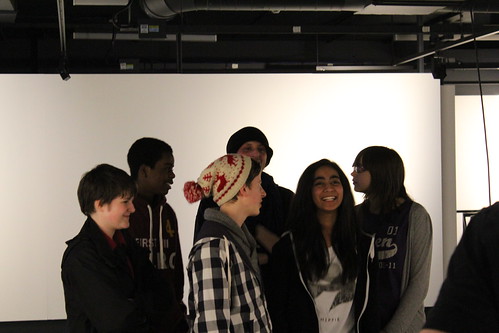
The project hasn't been all slaving over a hot camera: the group took a trip to Liverpool to see work on display at Tate Liverpool and FACT, examining what was good and bad about artworks and how they were displayed (and we've also had some great pizza...)
Slowly, the work came together over the autumn and winter and by the end of 2011 we had a bank of animations ready to assemble into one artwork. The final theme and name of the piece (System Overload) and a name for the group (Networked) were all worked out in January and added into the final display you'll see in the gallery. The last touch was to head to Factory Street Studios to compose a soundtrack to help create the mood we wanted.
Last week was the most exciting so far, as the group, Jack and the technicians gathered in Level 7 gallery to install the work. There were a couple of little issues but it was a generally smooth process and System Overload is now on the wall and ready to go when the gallery opens to the public on the 30 March 2012.
Later in the afternoon the local press were invited to see the work and meet the group – it was their first press event and despite having to be photographed from all angles and give soundbites they did really well.
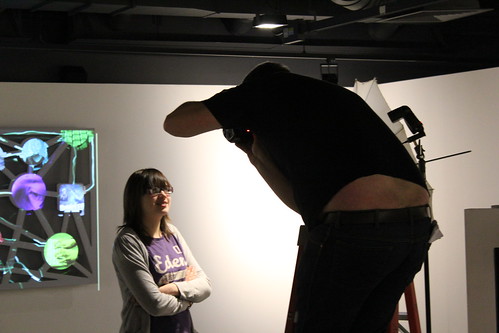
So, what's to come? The group are going to be spending the next couple of weeks working on some other creative projects, and then the gallery opens. If you want to learn more about the process why don't you come along to the Breakfast with the Artists event or visit Life Online [open source] from the 30 March to see the work in the gallery.
Six months ago, a group of dedicated young people came together to work on the development of a brand new artwork as part of the Life Online project. Here we are in February and the fruits of their labours have just been installed in the Level 7 gallery, as a piece called System Overload. So, how did we get here?

It all began back in September. A month earlier the group had voted to make an animation about net neutrality and with the help of artist Jack Lockhart they embarked on a series of workshops and activities. The aim: to learn how to animate and how to make cool art.
The first thing the group did was create a visual language to use, playing with concepts, ideas and techniques, working out how to represent abstract things like "the internet" as interesting animations. The results were three animation techniques: stop-motion, lightwriting and pixilation, and some ideas about where to go next. The group also researched the net neutrality and started to have ideas about why it's an important topic and what they wanted to say about it.

The next item on the agenda was to develop a structure for the artwork. As the piece was going in a gallery we didn't want a projection onto a wall, not when there was the chance to make something more interesting. As the group talked, the idea of using nodes and lines developed, and we combined this with experiments in projecting onto 3D objects like boxes. The result was a pattern, to be cut from wood and hung in the gallery: the animations would be projected on this later on.
With the structure in place we got on with animating. Led by our "meme master" Callum, the group started to create phrases and animations that explored net neutrality in the language of the internet: - Lolspeak (a language beyond us adults!)

The project hasn't been all slaving over a hot camera: the group took a trip to Liverpool to see work on display at Tate Liverpool and FACT, examining what was good and bad about artworks and how they were displayed (and we've also had some great pizza...)
Slowly, the work came together over the autumn and winter and by the end of 2011 we had a bank of animations ready to assemble into one artwork. The final theme and name of the piece (System Overload) and a name for the group (Networked) were all worked out in January and added into the final display you'll see in the gallery. The last touch was to head to Factory Street Studios to compose a soundtrack to help create the mood we wanted.
Last week was the most exciting so far, as the group, Jack and the technicians gathered in Level 7 gallery to install the work. There were a couple of little issues but it was a generally smooth process and System Overload is now on the wall and ready to go when the gallery opens to the public on the 30 March 2012.
Later in the afternoon the local press were invited to see the work and meet the group – it was their first press event and despite having to be photographed from all angles and give soundbites they did really well.

So, what's to come? The group are going to be spending the next couple of weeks working on some other creative projects, and then the gallery opens. If you want to learn more about the process why don't you come along to the Breakfast with the Artists event or visit Life Online [open source] from the 30 March to see the work in the gallery.
Labels:
dave smith,
galleries,
life online,
networked,
open source,
system overload,
youth engagement
Location:
Bradford, West Yorkshire, UK
15 February, 2012
Meet the Life Online Project Leader
Interested in finding out more about our brand new gallery, Life Online? Then meet Joe Brook, Life Online Project Leader to hear more about the inspiration behind the new space, and see a sneak preview.
Labels:
gallery,
joe brook,
life online,
video
Location:
Bradford, West Yorkshire, UK
10 February, 2012
Curating the Internet for Life Online
Blogger: Anna Ward, Content Developer
Seven weeks to go before Life Online opens to the public. The physical build is coming on, looming shapes have appeared in the foyer, and upstairs in Level 7, walls are appearing. Our technicians are ready to fit screens, lights and speakers, and the office is a hive of activity.
Behind the scenes at this stage, everything needs polishing and signing off. There are bits of text to finish, films to check, interactives and animations to be tested and improved, and content still to collect. We are liaising with external agencies about design, animations and games, and with artists about their installations in our temporary exhibition upstairs. All the while we are talking to the press and helping our marketing and PR teams to get the message out about the gallery.
In short, we're busy!
There is one area which still needs a lot of work, but when I describe it, you won't think it sounds like work at all.
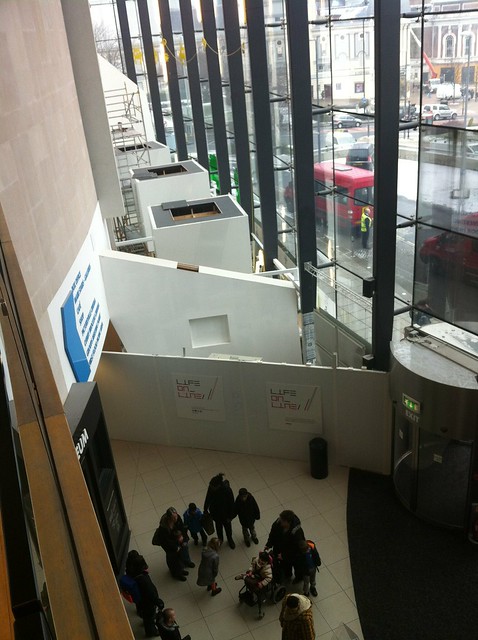
At the centre of the gallery there are three large projection zones. In the office we have been referring to these areas as the 'Cloud Browsers'... a meaningless name which has its routes in a long forgotten concept. They are Find Out More stations, with a twist. Because our gallery charts the history and impact of the internet, we need to represent the internet within the gallery. But of course, we cannot allow free and open access, especially not when someone's search results will be projected six feet high for all to see; so starts the job of curating... the internet!
Our Find Out More stations (the name is still up for debate - any suggestions welcome!) will expand on the topics explored elsewhere in the gallery. In them you will find articles produced by our curators, films made by our in-house media development team, and lots of relevant content streamed live from the internet. Hundreds of websites need to be found, checked for accuracy and interest and added to the relevant section in the Stations. For the next seven weeks I am paid to surf the web! Better get back to it...
Seven weeks to go before Life Online opens to the public. The physical build is coming on, looming shapes have appeared in the foyer, and upstairs in Level 7, walls are appearing. Our technicians are ready to fit screens, lights and speakers, and the office is a hive of activity.
Behind the scenes at this stage, everything needs polishing and signing off. There are bits of text to finish, films to check, interactives and animations to be tested and improved, and content still to collect. We are liaising with external agencies about design, animations and games, and with artists about their installations in our temporary exhibition upstairs. All the while we are talking to the press and helping our marketing and PR teams to get the message out about the gallery.
In short, we're busy!
There is one area which still needs a lot of work, but when I describe it, you won't think it sounds like work at all.

At the centre of the gallery there are three large projection zones. In the office we have been referring to these areas as the 'Cloud Browsers'... a meaningless name which has its routes in a long forgotten concept. They are Find Out More stations, with a twist. Because our gallery charts the history and impact of the internet, we need to represent the internet within the gallery. But of course, we cannot allow free and open access, especially not when someone's search results will be projected six feet high for all to see; so starts the job of curating... the internet!
Our Find Out More stations (the name is still up for debate - any suggestions welcome!) will expand on the topics explored elsewhere in the gallery. In them you will find articles produced by our curators, films made by our in-house media development team, and lots of relevant content streamed live from the internet. Hundreds of websites need to be found, checked for accuracy and interest and added to the relevant section in the Stations. For the next seven weeks I am paid to surf the web! Better get back to it...
Labels:
anna ward,
galleries,
internet,
life online,
new media
Location:
Bradford, West Yorkshire, UK
24 January, 2012
Podcast: Daniel Meadows discusses his Early Photographic Works
Daniel Meadows gave a wonderfully insightful, lively and engaging talk on Thursday, which formed part of an events programme that accompanied the showing of Daniel Meadows' first retrospective exhibition Daniel Meadows: Early Photographic Works in Gallery Two.
The talk was a sell out event, but you can hear it here.
The talk was a sell out event, but you can hear it here.
Labels:
daniel meadows,
exhibition,
photography
Location:
Bradford, West Yorkshire, UK
19 January, 2012
Introducing Life Online [open source]
Blogger: Sarah Crowther, Life Online Content Curator
March 2012 – February 2013
[open source] will be the first exhibition to open in our brand new Life Online exhibition space on the 7th floor. The gallery, which opens to the public on Friday 30th March 2012, has been created to explore key issues surrounding the internet and our relationship with it. A series of annual exhibitions will enable our visitors to further explore a number of the themes presented in the Life Online gallery in the foyer.
[open source] focuses on the internet's open culture of sharing and collaboration, while also considering threats to the neutrality of the network. If we fail to preserve net neutrality could we be facing the end of online culture as we know it? The exhibition will include a series of brand new commissions by internationally-renowned artists alongside an artwork created by the gallery's younger audience.
We'll be keeping you up to date on all the latest Life Online developments on this blog, so keep watching this space!
March 2012 – February 2013
[open source] will be the first exhibition to open in our brand new Life Online exhibition space on the 7th floor. The gallery, which opens to the public on Friday 30th March 2012, has been created to explore key issues surrounding the internet and our relationship with it. A series of annual exhibitions will enable our visitors to further explore a number of the themes presented in the Life Online gallery in the foyer.
[open source] focuses on the internet's open culture of sharing and collaboration, while also considering threats to the neutrality of the network. If we fail to preserve net neutrality could we be facing the end of online culture as we know it? The exhibition will include a series of brand new commissions by internationally-renowned artists alongside an artwork created by the gallery's younger audience.
We'll be keeping you up to date on all the latest Life Online developments on this blog, so keep watching this space!
Labels:
exhibition,
gallery,
internet,
life online,
new media,
open source,
sarah crowther
Location:
Bradford, West Yorkshire, UK
15 January, 2012
If you're looking for a photograph, try the Daily Herald Archive
Blogger: Caroline Dempsey, Collections Assistant
Ever wondered what your sister or father looked like on the day they emigrated to Australia? Looking for photographs of how your town looked 50 years ago, or searching for images of David Attenborough in his youth. There's a good chance that the image you're searching for is in the Daily Herald Archive.
The Daily Herald archive comprises over 3 million photographs covering a period from 1911 through to the 1960s. The archive is broadly split into three sections: places, events and people.
Requests are many and varied, and although the photograph you are searching for may not be in the archive, a search is always conducted and often we find just what you were after.
Here are some of the photographs we found for members of the public last year:
Caroline Williamson emailed from Australia, her grandfather was the Welsh politician Siegfried Owen Davies who accompanied the then King Edward around the Dowlais Steel Works in 1936. Her grandfather's file of photographs, taken over the many years he spent as a Member of Parliament, included one of him at Dowlais taken by the Herald photographer Edward Malindine.
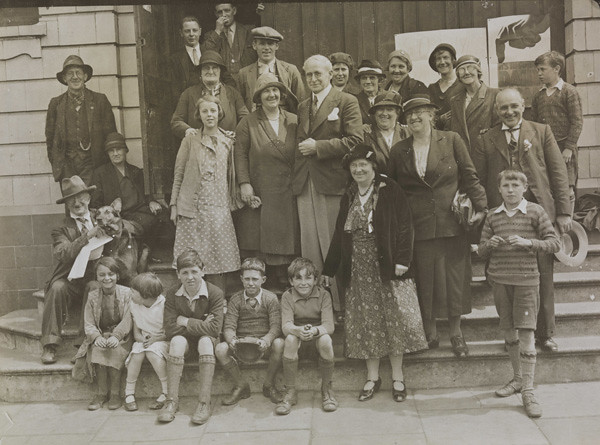
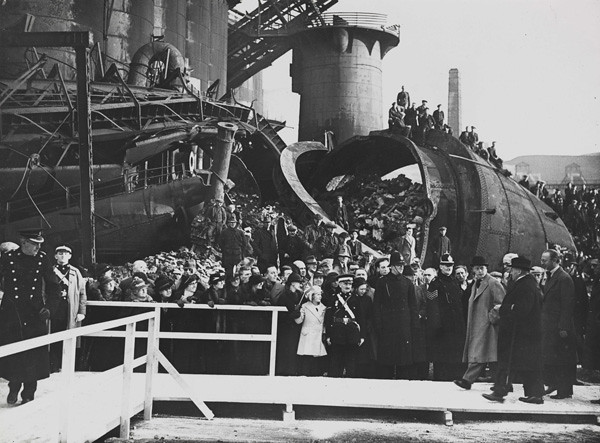
Another Australian Stephen Mole contacted us, he was looking for a photograph of his father, Patrick, on the day he emigrated to Australia in 1949. His dad was 14 at the time and kept a diary recording his trip down under. We managed to find a photograph of the whole family as they set sail for Tasmania in time for a family celebration.

Barry Flynn remembered a Daily Herald photographer coming to his house in Liverpool in 1959. The paper was writing an article about the training of police dogs and Barry, aged 8 at the time, was photographed with his father's police dog "Jet" at their Allerton home.
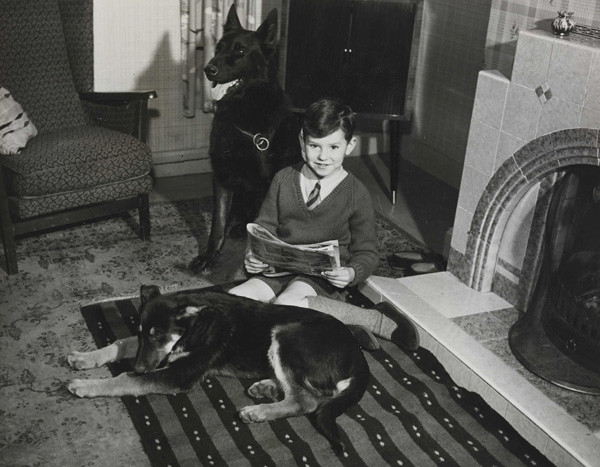
So whether you have a relation who was a Past Miss Ireland, an artist, pilot, sports star, boxing referee or model we may have a photograph of them in the archive. Did your relative play host to Mahatma Gandhi when he toured England in 1931? A Mrs J P Davies did and her photograph is here in the archive.
Did your parents emigrate to New Zealand on board the "Rangitata" in 1947? Were you one of the 14 members of the Jones family of Chatham, Kent who moved to New Zealand in 1960 or one of the many Over-Seas League Child Migrants?
Perhaps you are a member of the Reading based Torpedoes Football Club who emigrated to Australia on masse in 1969. Or one of the Finnegan's from Dublin who in 1966 were bound for Ontario. Or a Templeton from Kingston, Jamaica on their way to the UK. If you think we might have the image you're after contact us and we'll conduct a search for you.
Ever wondered what your sister or father looked like on the day they emigrated to Australia? Looking for photographs of how your town looked 50 years ago, or searching for images of David Attenborough in his youth. There's a good chance that the image you're searching for is in the Daily Herald Archive.
The Daily Herald archive comprises over 3 million photographs covering a period from 1911 through to the 1960s. The archive is broadly split into three sections: places, events and people.
Requests are many and varied, and although the photograph you are searching for may not be in the archive, a search is always conducted and often we find just what you were after.
Here are some of the photographs we found for members of the public last year:
Caroline Williamson emailed from Australia, her grandfather was the Welsh politician Siegfried Owen Davies who accompanied the then King Edward around the Dowlais Steel Works in 1936. Her grandfather's file of photographs, taken over the many years he spent as a Member of Parliament, included one of him at Dowlais taken by the Herald photographer Edward Malindine.


Another Australian Stephen Mole contacted us, he was looking for a photograph of his father, Patrick, on the day he emigrated to Australia in 1949. His dad was 14 at the time and kept a diary recording his trip down under. We managed to find a photograph of the whole family as they set sail for Tasmania in time for a family celebration.

Barry Flynn remembered a Daily Herald photographer coming to his house in Liverpool in 1959. The paper was writing an article about the training of police dogs and Barry, aged 8 at the time, was photographed with his father's police dog "Jet" at their Allerton home.

So whether you have a relation who was a Past Miss Ireland, an artist, pilot, sports star, boxing referee or model we may have a photograph of them in the archive. Did your relative play host to Mahatma Gandhi when he toured England in 1931? A Mrs J P Davies did and her photograph is here in the archive.
Did your parents emigrate to New Zealand on board the "Rangitata" in 1947? Were you one of the 14 members of the Jones family of Chatham, Kent who moved to New Zealand in 1960 or one of the many Over-Seas League Child Migrants?
Perhaps you are a member of the Reading based Torpedoes Football Club who emigrated to Australia on masse in 1969. Or one of the Finnegan's from Dublin who in 1966 were bound for Ontario. Or a Templeton from Kingston, Jamaica on their way to the UK. If you think we might have the image you're after contact us and we'll conduct a search for you.
Labels:
archive,
caroline dempsey,
collection,
daily herald,
edward malindine,
photography
Location:
Bradford, West Yorkshire, UK
10 January, 2012
Life Online gallery starts to take shape
Blogger: Joe Brook, Media and Galleries Manager
We've moved into the really exciting final phase of the Life Online gallery build, where the 2D concepts are finally coming to life.
The team worked for five years from drawings and plans; tweaking, adjusting, testing - sometimes throwing an idea away and starting again.
Once our concepts are fixed and we know that we can afford to build everything, the construction drawings are produced and issued to various contractors, and the physical gallery starts to take shape.
While the build progresses, the team continues to refine the content of the gallery: graphics, video, text, interactive elements and objects. Every single surface, image, seat, touch-screen, projector, object, case and video has to be carefully considered, designed and put together in time for the opening. Meanwhile, the project managers work very hard to ensure that everyone gets paid, contracts are signed, everyone is safe and that we stick to our schedule.
My job is to ensure that all of the different elements work together harmoniously, that we achieve what we set out to do and, most importantly, that all the bits and pieces which make up the gallery tell a story in a way in which people will enjoy.
Today I visited the workshop of TTS Interiors - the fantastic guys who are translating the drawings into real objects that you will touch and see when you visit. Roy, our lead designer from NRN Design came along to make sure everyone was happy with what he'd drawn, to answer any questions and resolve any issues that inevitably crop up during the manufacturing process.
Working together we resolved any remaining decisions, like the height of uplights, access to the building's heating system, the positioning of some final power outlets and cable routing for a problematic projector. We looked over a prototype interactive kiosk enclosure, show cases and various wall structures, and finally, gave the approval for manufacture to proceed ready to be loaded into trucks and brought to the Museum in a few weeks for installation.
Here are some snapshots of the objects which you'll see in the gallery. Can you tell what they are?

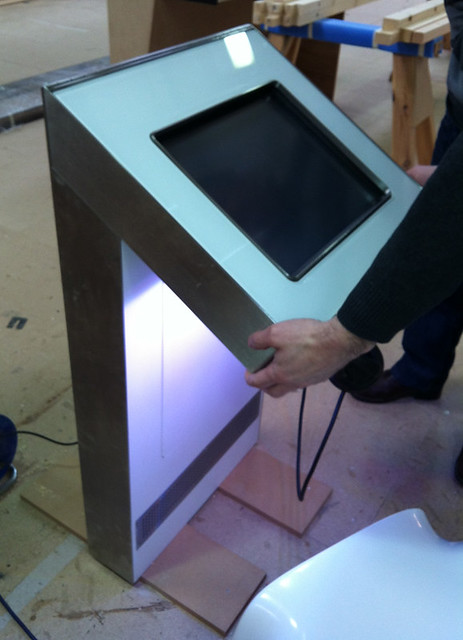

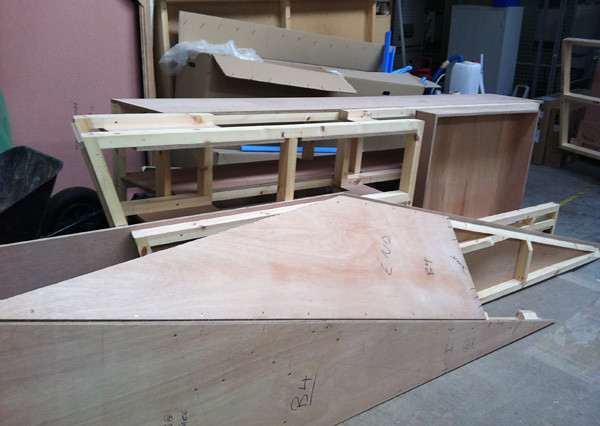
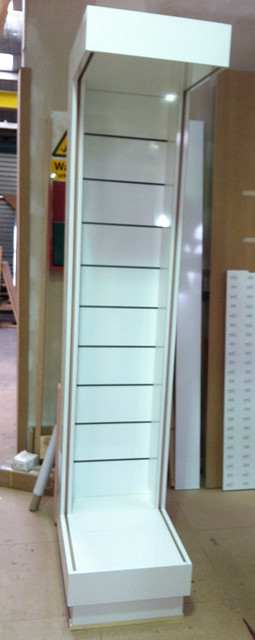
We've moved into the really exciting final phase of the Life Online gallery build, where the 2D concepts are finally coming to life.
The team worked for five years from drawings and plans; tweaking, adjusting, testing - sometimes throwing an idea away and starting again.
Once our concepts are fixed and we know that we can afford to build everything, the construction drawings are produced and issued to various contractors, and the physical gallery starts to take shape.
While the build progresses, the team continues to refine the content of the gallery: graphics, video, text, interactive elements and objects. Every single surface, image, seat, touch-screen, projector, object, case and video has to be carefully considered, designed and put together in time for the opening. Meanwhile, the project managers work very hard to ensure that everyone gets paid, contracts are signed, everyone is safe and that we stick to our schedule.
My job is to ensure that all of the different elements work together harmoniously, that we achieve what we set out to do and, most importantly, that all the bits and pieces which make up the gallery tell a story in a way in which people will enjoy.
Today I visited the workshop of TTS Interiors - the fantastic guys who are translating the drawings into real objects that you will touch and see when you visit. Roy, our lead designer from NRN Design came along to make sure everyone was happy with what he'd drawn, to answer any questions and resolve any issues that inevitably crop up during the manufacturing process.
Working together we resolved any remaining decisions, like the height of uplights, access to the building's heating system, the positioning of some final power outlets and cable routing for a problematic projector. We looked over a prototype interactive kiosk enclosure, show cases and various wall structures, and finally, gave the approval for manufacture to proceed ready to be loaded into trucks and brought to the Museum in a few weeks for installation.
Here are some snapshots of the objects which you'll see in the gallery. Can you tell what they are?





Labels:
design,
gallery,
interactives,
joe brook,
life online,
project
Location:
Bradford, West Yorkshire, UK
06 January, 2012
Online moments of 2011
Blogger: Tom Woolley, Curator of New Media
Personally, I feel that the stream of updates through social networks and constant connectivity has had a strange affect on my time. Days feel like they pass more quickly than ever but thinking back to this time 12 months ago, seems, to borrow Cerf's comparison, like a dog year. Perhaps it's due to the fact that I'm rarely ever bored - those moments of being at a loose end when waiting for a bus have evaporated thanks to my iPhone. Or that I feel more connected to breaking news and analysis than ever - I'm consuming so much information that maybe my brain is being tricked into thinking time is expanding.
2011 has certainly been a monumental year online and January 2011 feels like a long time ago. This was the start of the Arab Spring and the real power of social media was demonstrated by helping to unite civilians to rise up against their tyrannical governments.
It could be argued that civil revolutions would have happened anyway without the use of Twitter and Facebook but never before have groups been able to organise themselves so efficiently and attract the attention of the world. The Egyptian authorities' nervousness came to a head on January 27th when the government made the unprecedented move of cutting the nation's internet.

Credit: Khaled Desouki / AFP / Getty Images
#egypt was revealed as the number one trending hashtag on Twitter and #jan25 – the date the civil revolution started in Egypt - also appeared as the eighth most popular hashtag on Twitter's Year in Review.
In contrast, social media was held responsible for its role in August's London riots. A 7000-strong Facebook group mourning the death of Tottenham resident Mark Duggan quickly started to mention vows of revenge against the Metropolitan police, and the Blackberry Instant Messenger service proved a useful tool for the rioters to coordinate themselves without being traced.
British internet censorship was also considered by the government as a way to prevent future acts of violence and looting spreading. Conversely, the post-riot public cleanup was coordinated through the website www.riotcleanup.co.uk.
Another example of online people power was the high profile exploits of hacking collectives Anonymous and Lulzsec. Seemingly unstoppable and untraceable, Anonymous were successful in hacking Sony Playstation and the emails of Bank of America, whilst Lulzsec launched an attack on News International.
More anonymous behaviour on Twitter saw the release of the celebs behind the super injunctions and British Twitter users flocked to the site to read the gossip first.
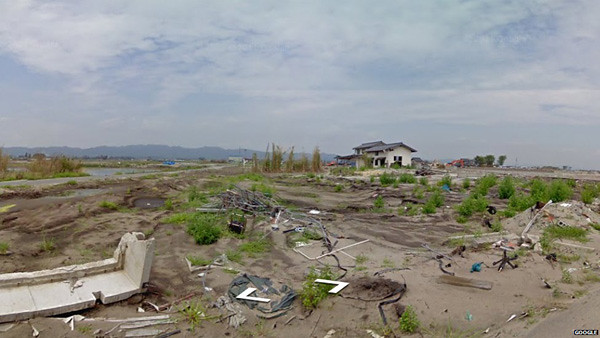
Credit: Google Street View
The tragic Japanese earthquake and tsunami caused the #japan hashtag to be the fifth most used term of the year and Google's Street View cameras revisited the country's roads to reveal haunting images of the devastation.
Lieutenant John Pike became an internet target after a video of him casually spraying a group of protesting students at University of California Davis went viral. Hollywood actor Charlie Sheen also became a viral sensation after his appearance on Good Morning America and gave birth to new internet lingo such as 'tigerblood' and 'winning'.
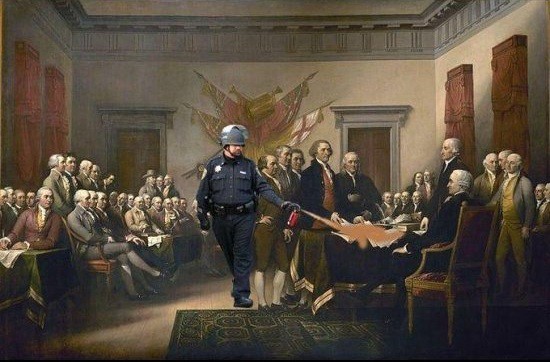
Lieutenant John Pike became an internet meme in 2011
Rebecca Black became one of the net's fastest rising stars with the release of her 'Friday' music video in February, but one of the most truly shocking and uncomfortable watches for me was this video of a racist tirade on a London tram.
Other moments include the online public outpouring of grief for the death of Apple co-founder Steve Jobs and watching celebrities and footballers duke it out on Twitter.
And of course, I couldn't let 2011 pass without mentioning Nyan Cat – 57 million views and counting!
These moments are really just scratching the surface of what happened online in 2011. What other memorable moments have I missed?
Many of these stories will find their way into our new Life Online gallery - a permanent exhibition at the Museum that will track the evolution and impact of the internet. The gallery has been designed so it can be updated easily and capture new landmark moments. I wonder what moments will define the coming year? Life Online is set to launch on March 30th 2012.
"Well, they say a year in the Internet business is like a dog year - equivalent to seven years in a regular person's life. In other words, it's evolving fast and faster."I think Vint Cerf's observation about the rapid development of internet technology can also be applied to our everyday lives on the net.
- Vint Cerf, father of the internet and Chief Internet Evangelist at Google.
Personally, I feel that the stream of updates through social networks and constant connectivity has had a strange affect on my time. Days feel like they pass more quickly than ever but thinking back to this time 12 months ago, seems, to borrow Cerf's comparison, like a dog year. Perhaps it's due to the fact that I'm rarely ever bored - those moments of being at a loose end when waiting for a bus have evaporated thanks to my iPhone. Or that I feel more connected to breaking news and analysis than ever - I'm consuming so much information that maybe my brain is being tricked into thinking time is expanding.
2011 has certainly been a monumental year online and January 2011 feels like a long time ago. This was the start of the Arab Spring and the real power of social media was demonstrated by helping to unite civilians to rise up against their tyrannical governments.
It could be argued that civil revolutions would have happened anyway without the use of Twitter and Facebook but never before have groups been able to organise themselves so efficiently and attract the attention of the world. The Egyptian authorities' nervousness came to a head on January 27th when the government made the unprecedented move of cutting the nation's internet.

Credit: Khaled Desouki / AFP / Getty Images
#egypt was revealed as the number one trending hashtag on Twitter and #jan25 – the date the civil revolution started in Egypt - also appeared as the eighth most popular hashtag on Twitter's Year in Review.
In contrast, social media was held responsible for its role in August's London riots. A 7000-strong Facebook group mourning the death of Tottenham resident Mark Duggan quickly started to mention vows of revenge against the Metropolitan police, and the Blackberry Instant Messenger service proved a useful tool for the rioters to coordinate themselves without being traced.
British internet censorship was also considered by the government as a way to prevent future acts of violence and looting spreading. Conversely, the post-riot public cleanup was coordinated through the website www.riotcleanup.co.uk.
Another example of online people power was the high profile exploits of hacking collectives Anonymous and Lulzsec. Seemingly unstoppable and untraceable, Anonymous were successful in hacking Sony Playstation and the emails of Bank of America, whilst Lulzsec launched an attack on News International.
More anonymous behaviour on Twitter saw the release of the celebs behind the super injunctions and British Twitter users flocked to the site to read the gossip first.

Credit: Google Street View
The tragic Japanese earthquake and tsunami caused the #japan hashtag to be the fifth most used term of the year and Google's Street View cameras revisited the country's roads to reveal haunting images of the devastation.
Lieutenant John Pike became an internet target after a video of him casually spraying a group of protesting students at University of California Davis went viral. Hollywood actor Charlie Sheen also became a viral sensation after his appearance on Good Morning America and gave birth to new internet lingo such as 'tigerblood' and 'winning'.

Lieutenant John Pike became an internet meme in 2011
Rebecca Black became one of the net's fastest rising stars with the release of her 'Friday' music video in February, but one of the most truly shocking and uncomfortable watches for me was this video of a racist tirade on a London tram.
Other moments include the online public outpouring of grief for the death of Apple co-founder Steve Jobs and watching celebrities and footballers duke it out on Twitter.
And of course, I couldn't let 2011 pass without mentioning Nyan Cat – 57 million views and counting!
These moments are really just scratching the surface of what happened online in 2011. What other memorable moments have I missed?
Many of these stories will find their way into our new Life Online gallery - a permanent exhibition at the Museum that will track the evolution and impact of the internet. The gallery has been designed so it can be updated easily and capture new landmark moments. I wonder what moments will define the coming year? Life Online is set to launch on March 30th 2012.
Labels:
blackberry,
censorship,
charlie sheen,
egypt revolution,
hashtag,
internet,
john pike,
life online,
london riot,
lulzsec,
new media,
news international,
nyan cat,
tom woolley,
twitter,
vint cerf
Location:
Bradford, West Yorkshire, UK
Eve Arnold: 21 April 1912 - 4 Jan 2012
Blogger: Greg Hobson, Curator of Photography
It is with great sadness that we have heard of the death on 4th January of legendary photographer, Eve Arnold at the age of 99.
Eve Arnold was a remarkable documentary photographer whose extraordinarily long career produced many memorable photo stories; a result of her empathic and friendly nature, and tenacious work ethic. She had a fruitful relationship with this Museum, sitting for a time on its Advisory Board and exhibiting solo shows here on two occasions.
A master of the photo essay, Arnold's enthusiasm for photography and her adaptability, meant that she excelled in all her work, whether photographing the world's poor and disenfranchised, or making intimate, behind the scenes portraits of some of Hollywood's biggest film stars.
Useful Links:
Eve Arnold obituary - Amanda Hopkinson, The Guardian
Magnum Photos
It is with great sadness that we have heard of the death on 4th January of legendary photographer, Eve Arnold at the age of 99.
Eve Arnold was a remarkable documentary photographer whose extraordinarily long career produced many memorable photo stories; a result of her empathic and friendly nature, and tenacious work ethic. She had a fruitful relationship with this Museum, sitting for a time on its Advisory Board and exhibiting solo shows here on two occasions.
A master of the photo essay, Arnold's enthusiasm for photography and her adaptability, meant that she excelled in all her work, whether photographing the world's poor and disenfranchised, or making intimate, behind the scenes portraits of some of Hollywood's biggest film stars.
Useful Links:
Eve Arnold obituary - Amanda Hopkinson, The Guardian
Magnum Photos
Labels:
eve arnold,
greg hobson,
obituary,
photography
Location:
Bradford, West Yorkshire, UK
03 January, 2012
Our favourite films of 2011
Blogger: Tom Vincent, Film Programme Manager
The results of our poll of Museum staff's favourite films of 2011 are in! Each contributor was asked to name five favourite new films that played in UK cinema in 2011. Beginning with an interesting tie for first place, our list of most-loved films is, as usual, broad and varied. Eleven people cast their 55 votes for 41 films, with 32 of those either shown at the Museum, or coming here early this year.
Please use the comments section below to let us know your favourites, or tell us what you think of ours.
Blue Valentine
Le quattro volte
Animal Kingdom
Essential Killing
Meek's Cutoff
Melancholia
A Separation
Shame (Leeds International Film Festival; London Film Festival)
The Skin I Live In
Source Code
We Need to Talk About Kevin
13 Assassins
Archipelago
Black Power Mixtape 1967-1975
Captain America: The First Avenger
Cave of Forgotten Dreams
The Descendants (London Film Festival)
The Divide (Leeds International Film Festival)
Drive
The Future
How I Ended This Summer
Hugo
Kill List
The King's Speech
LiTTLEROCK (Bradford International Film Festival)
Never Let Me Go
Pina
Rango
The River Used to be a Man (Leeds International Film Festival)
Senna
Submarine
Super 8
Symbol (Leeds International Film Festival)
True Grit
Win Win
The results of our poll of Museum staff's favourite films of 2011 are in! Each contributor was asked to name five favourite new films that played in UK cinema in 2011. Beginning with an interesting tie for first place, our list of most-loved films is, as usual, broad and varied. Eleven people cast their 55 votes for 41 films, with 32 of those either shown at the Museum, or coming here early this year.
Please use the comments section below to let us know your favourites, or tell us what you think of ours.
- The whole thing is such a genuine look at married life. It's not harrowing and relentless, nor is it Hollywood convenient; it's just very honest. (Mike McKenny, Museum Volunteer and Director of Minicine)
- Great natural chemistry between Ryan Gosling and Michelle Williams. (Tom Woolley, Curator of New Media)
- Heartbreaking. Ryan Gosling and Michelle Williams are simply brilliant. You will not find two more accomplished performances this year. (Ben Haller, Customer and Colleague Service Champion)
- Went into this not knowing what to expect and was seduced by its beautiful, slow-paced nature. Lingered on my mind for months. (TW)
- The finest canine sequence in years, and the goats were good as well. (Keith Withall, Film Extra tutor)
- True craftsmanship. Moving, heart warming and real. (Toni Booth, Collections Manager)
- "Do you come from a land Down Under? / Where women glow and men plunder / Can't you hear, can't you hear the thunder? / You better run, you better take cover." (Neil Young, Co-Director, Bradford International Film Festival)
- This was my special mention for 2011 on last year's list and it's still up there, what a mother... (Jen Skinner, Film Education Officer)
- A total surprise. Very powerful with a great central performance by Vincent Gallo. (TB)
- Terrorism reduced to sheer effort; a film with very little story information that somehow achieves total clarity. (TV)
- Perfect example of anti-genre. Completely aware of its mythic Western context, but strips away the spectacle to criticise and deconstruct. (MM)
- A women's viewpoint on the West, and one exquisite lap dissolve. (KW)
- Sardonic, sarcastic and complex but still generating great emotion. (KW)
- Armageddon takes very much a back seat in this enigmatic examination of depression and reactions to a crisis. (Sven Shaw - Assistant Gallery Developer)
- Beautifully produced and the cast deservedly swept the acting awards at the Berlin Film Festival. (KW)
- Incredibly mature filmmaking that looks understated but held all those different characters' complex and contradictory feelings in play throughout the whole film. (Rona Murray, Film Extra tutor)
- A stylish and compelling observation of personal detachment. (TW)
- No-one clapped, too uncomfortable. I'm still thinking about it – I think that's part of what Steve McQueen does best. (RM)
- Deliberate 'trash' and high art megamix from the master. They slagged it at the BBC4 World Cinema Awards – which makes you love it more, somehow. (RM)
- Very original and surprising tale of revenge and personal identity. (SS)
- Much like Rodrigo Cortes' fine Buried last year, Source Code built upon breaking the confines of one-shot film-making. Refreshingly inventive and story-driven, I was gripped throughout. (BH)
- Superb Hollywood sci-fi. (TW)
- Disturbingly beautiful and it's by Lynne Ramsay who is just brilliant, so deserves a place on my list. (JS)
- Wonderful combination of beauty and horror. (TB)
- No it's not a straight adaptation, so what? Its quality of silence and visuality were just intensely felt and amazingly consistent across a whole feature. (RM)
- It captured the passion and violence that I felt when I first read Emily Brontë's novel, and it was filmed in Yorkshire. (KW)
- Takashi 'four-a-year' Miike is a compulsive lunatic genius. Like fellow great subversive John Waters, he has glorious fun on the banks of the mainstream. (TV)
- If Joanna Hogg spends the rest of her career making films about posh families on awkward holidays overseas, why should anyone complain? (NY)
- Fine, free edit work on Swedish film crews' recordings of the unravelling strands of U.S. Black Power movements. This film proved the maxim: 'show, don't tell'. (TV)
- Intelligent and thoroughly enjoyable, terrific performances and original action sequences make this the best of the Avenger series by far. Hayley Atwell is mesmerising as Agent Carter. (BH)
- The ever reliable and idiosyncratic Herzog. (TB)
- 35 years ago America produced mature, emotionally complex films like this every week. Alexander Payne is my favourite American director working today. (TV)
- Frontière director Xavier Gens bounces back from the studio peril that was Hitman with an intelligent, visually rich and outstandingly acted horror film which suggests hell really is other people. (Sarah Crowther – Life Online Content Curator and Director, Fantastic Films Weekend)
- The most exhilarating couple of hours I've spent in a cinema all year, terrific! (BH)
- Prrrrrrrrrrrrrrrrrrrrrrrrrrrrrrrrrrrrrrrrrrrrrrrrrrrrrrrrrrrr... (NY)
- Absolutely true to its Grindhouse origins, Hobo... is outrageous, visually rich and the most fun to be had in a cinema this year. (SC)
- Desolation and isolation pushed to the very extreme. There have been some fantastic patient films this year, but few - if any - as patient as this one. (MM)
- Martin Scorsese's ode to the magical Georges Méliès and a celebration of cinematic dreams. What's not to like? (JS)
- The most fun we had in a cinema this year with our clothes on. (Optional) (NY)
- British horror as it should be. (SC)
- A moving tale of friendship across the class divide with great lead performances. (SS)
- Beautiful depiction of adolescent communication. Invokes a sense of unease throughout. A touching love letter to small town America, so often either simplified or demonised by mainstream American cinema. (MM)
- German director Andreas Marschall's love letter to Giallo. An atmospheric study in Argento and Lamberto Bava, Masks features the best opening sequence of the year. (SC)
- A love story and sci-fi rolled into one. I found the film detached, cold but totally compelling. (SS)
- Feel-good film of the year! The fluidity, grace and passion of the dancers were completely inspiring. (RM)
- Some irony in the fact that Johnny Depp's finest hour (and a half) involves no glimpse of his fabled visage. (NY)
- This film utilises masterful cinematography in order for you to soak in the natural beauty - and natural peril - of the African wilderness. (MM)
- I had no interest in Formula One but was totally gripped to this film. Asif Kapadia played this epic story out in a fascinating way. (JS)
- I'm a sucker for a misfit film. Great cast, visually very pleasing, a fantastic soundtrack and Paddy Considine with a mullet - what more could you want? (JS)
- Was this a satirical take on 80s action movies or an overblown mishmash of genres? It doesn't really matter when a film's this much fun. (SS)
- Just about indescribable, and more profound than The Tree of Life (and with a great sense of humour) (TB)
- Watching this fluid, expressive documentary on five highly individual Japanese photographers is the kind of experience that makes organising film festivals worthwhile. (TV)
- A rollicking Coen brothers remake. Loved every minute of it. (TW)
- British horror as it should be. (SC)
- Quirky, funny, true and passionate! A life-affirming insight into nowhere-America and a glimpse of hope for middle-age men everywhere. Tom McCarthy has now written The Station Agent, The Visitor, Up and Win Win! (BW)
Labels:
cinema,
cinematography,
film,
films of 2011,
review,
Tom Vincent
Location:
Bradford, West Yorkshire, UK
Subscribe to:
Comments (Atom)

